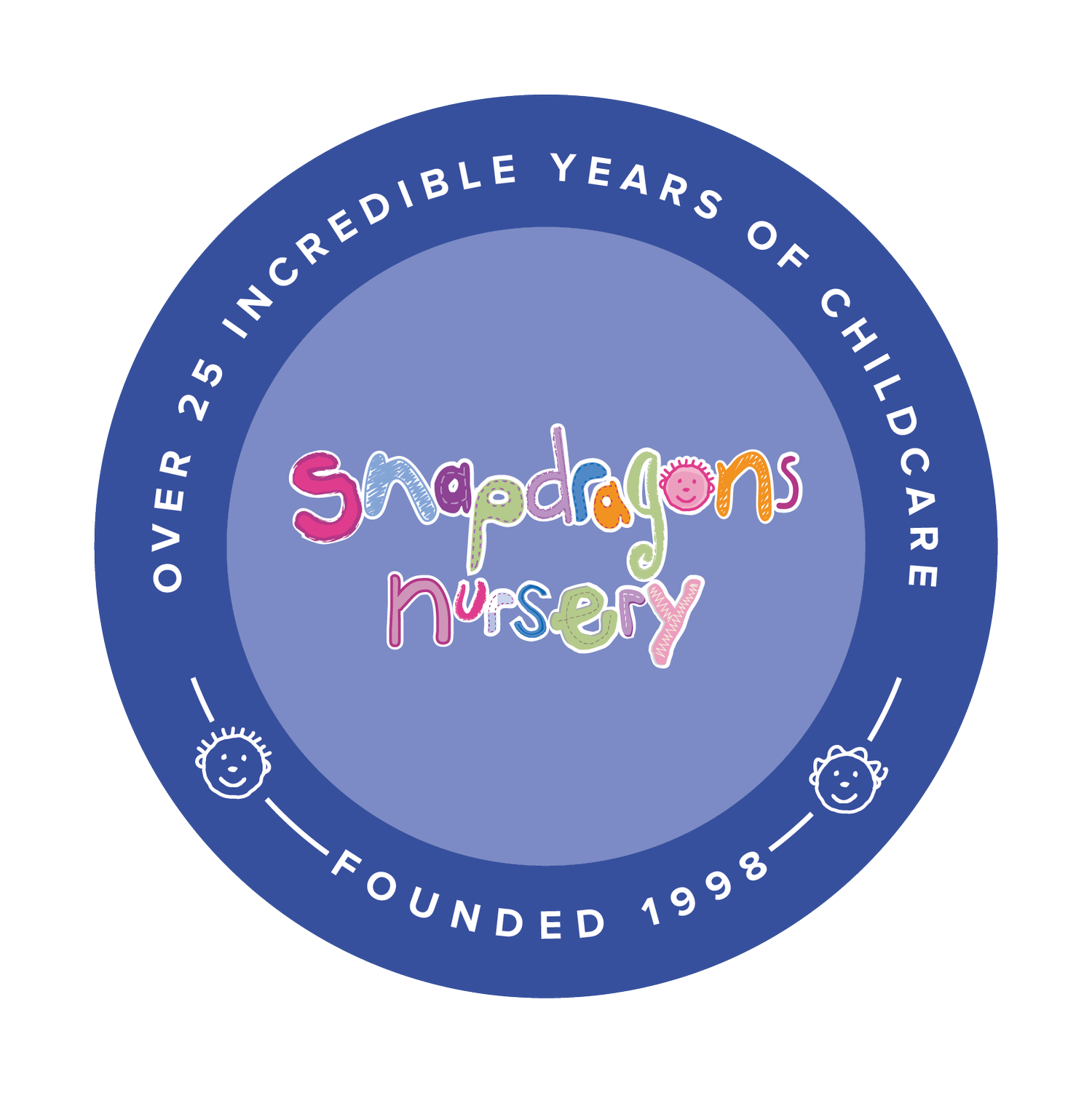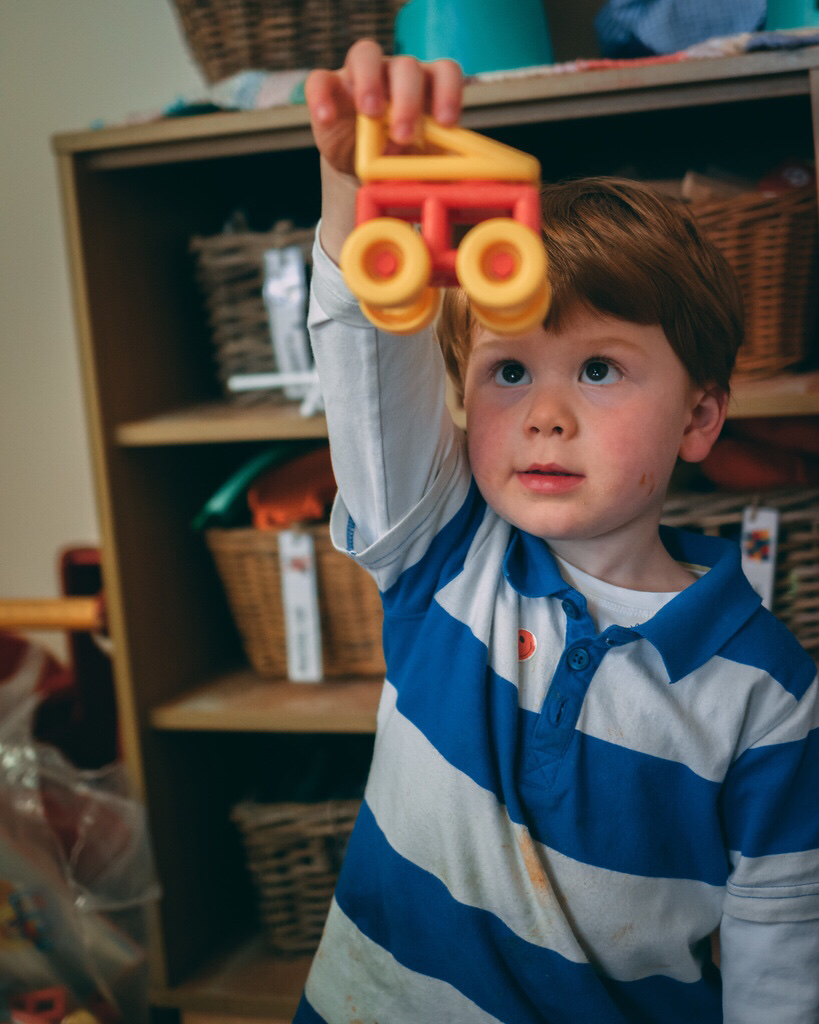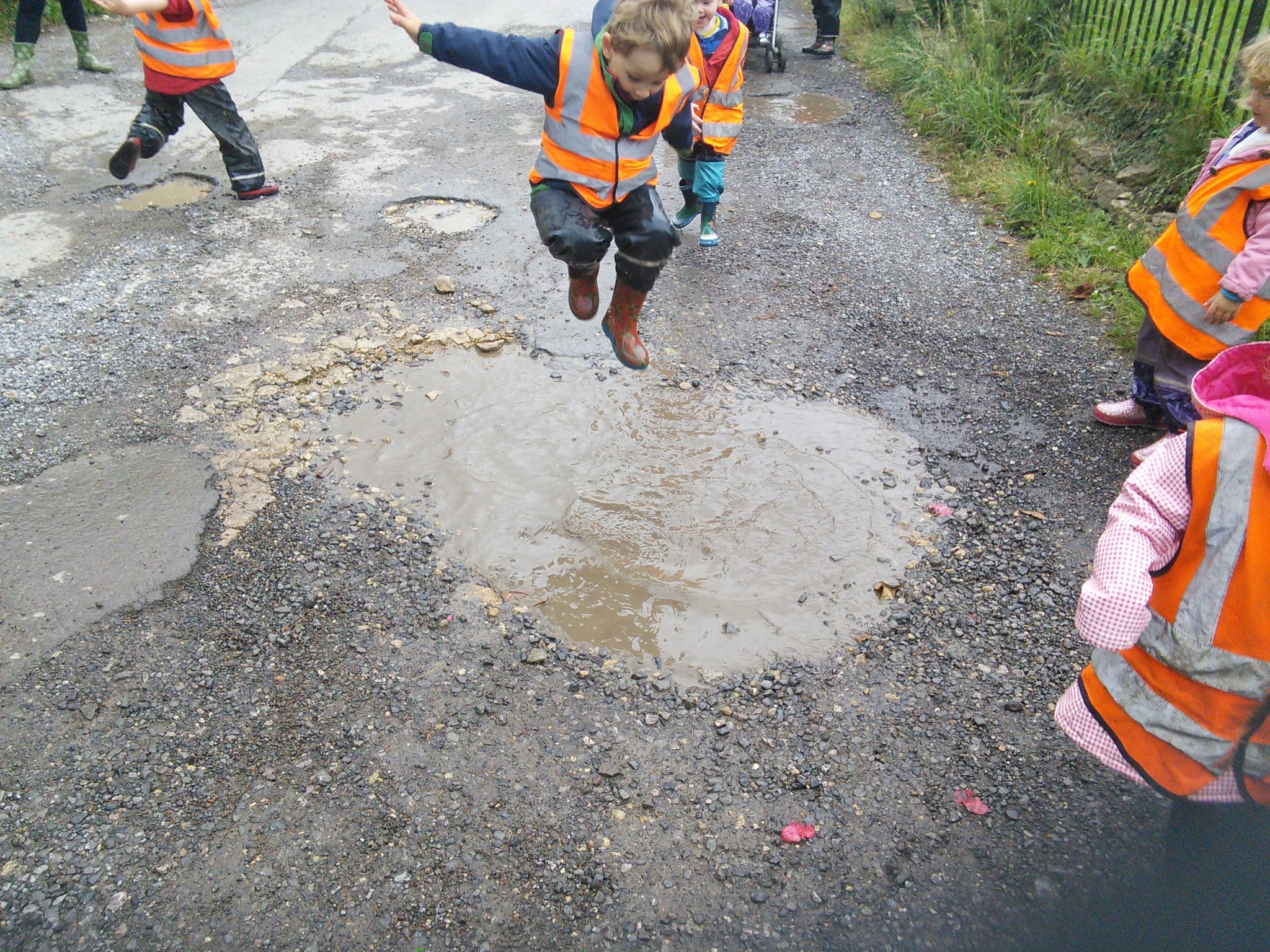
Constructing new ideas
Construction sets are always one of the most popular and well used resources in Nursery. One we have provided for many years is Mobilo. It contains multiple connectors and a variety of pieces of different sizes and shapes that give children enough scope to make choices and build many static and moveable models. This gives so many opportunities for learning across the early years curriculum.
Mobilo is a useful resource for many aspects of mathematics. The individual components contain different shapes so meaningful learning can be applied in the context of the children’s hands on play. When using the set, you can talk together about the shapes they have used or need more of, which work well and why, and use combinations of shapes to represent and symbolise other things.
The angled triangular pieces are frequently used for making space rockets and airplanes, as the children use them for the streamlined nose and for the wings. The most adept rocket builders use the connecters to angle and adjust the take off, flying and landing position of the wings.
The concept and language of size also emerges and can be developed through this form of construction play. The elements lend themselves to size description and comparison when talking about their choices and intentions and their ongoing or finished creations. Models may be simply big or small, but scope for talking about whether they are long, short, high or low, even wide or narrow can be developed through conversation whilst playing together. A recurring theme for our children is connecting up the long, flat rectangular pieces to build ladders for fire engines.
The flexibility of Mobilo really supports children’s creativity and imagination because they can make whatever they want to, and change it along the way. Our preschool children use the models they made to create toys to play with such as trains, cars and lorries. They quickly find out that the different connecters allow for a range of movements, some can create a bending motion, others let a piece rotate right around. Once this is discovered then helicopters and wind mills can be explored. Connecting pieces can also be used to make boundaries for toy animals.
Props for use in role play also become evident such as mobile phones, and items from their first hand experiences like thermometers, hammers and even necklaces. This really supports the children’s social interaction and language. The children’s fine motor skills are continually being challenged and developed due to the manipulative actions required to join the construction pieces together securely.
Some children like the challenge of using the activity cards and problem solving how to recreate the model shown in the picture by matching the exact shapes and colours and counting how many of each part they need. However it is the open ended nature of Mobilo that truly enables children to really extend their thinking, and engage in symbolic play where there are no limits to their ideas.
Breaking the obesity cycle
Type 2 diabetes amongst children, once almost unheard of, is on the increase according to a report by the Royal College of Paediatrics and Child Health. They found that more than 600 children and young people under 25 were treated for Type 2 diabetes in 2015/16 in England and Wales, including some aged between five and nine. 78% of the young people in the audit were also categorised as obese, a strong contributing factor in the development of Type 2 diabetes along with unhealthy diets.
According to government figures, around one in five children starting primary school now is overweight or obese and the figure rises to one in three by the time they leave. That’s one in three children who have an increased risk of developing Type 2 diabetes in later life and facing the possibility of associated health problems like amputations, blindness, heart attacks and strokes if they don’t learn how to manage their weight and eating habits effectively.
The cost of this to the NHS, and therefore to us all, is going to be horrifying if nothing is done to reverse the trend. The government has responded by launching a new initiative to get food manufacturers to reduce the calories in some of the most popular products like ready meals, pizzas, burgers, sandwiches and savoury snacks. This initiative follows the push to reduce salt and then sugar which evolved into the Change 4 Life Sugar Smart app. Public Health England will be setting targets aimed at reducing calories in meals, snacks and drinks from supermarkets, restaurants and takeaways and, although these will be voluntary, they could be followed by legislation if the industry does not respond.
The trouble is, that we’ve been here before and nothing changes. When products are labelled as “healthy” because they are low fat, we then discover that the sugar or salt content has been doubled to compensate for the lack of flavour and preservative property of the fat. Salt, sugar and fat are what makes ready meals and takeaways so addictive and our taste buds have been trained to want more and more. Ready meals, snacks and sugary drinks are inherently unhealthy and many contain long lists of unappetising ingredients which really cannot lead to a healthy diet. Check out the ingredients in this popular food item and see if you can guess what it is:
Soybean Oil (Antioxidant (330)), Water, Relish [ Pickles, High Fructose Corn Syrup, Sugar, Distilled Vinegar, Preservative (202), Thickener (415), Flavourings], Mustard [Water, Distilled Vinegar, Mustard Seed, Salt, Sugar, Colours (150d, 100), Spice], Salted Egg Yolks, Distilled Vinegar, Onion, Thickeners (1442, 415, 405), Spices, Sugar, Salt, Hydrolysed Protein (Corn Gluten, Soy, Wheat Gluten), Preservative (211), Colours (160c, 150d, 100), Emulsifier (433), Garlic, Antioxidant (385).
Sounds delicious doesn’t it? These are the ingredients in the special sauce on a MacDonalds big mac apparently. It doesn’t take a genius to see that a diet so full of articial “food” is never going to be a healthy option.
I don’t think we should leave our health and that of our children at the mercy of big food manufacturers at all. Let’s give our children back the power to control their own health by reducing their reliance on convenience foods. The importance of all aspects of our food and health, including growing, cooking from scratch, eating more fruit and vegetables and cutting down on meat (especially hormone and antibiotic-pumped, mass-produced meat) and taking regular exercise should be taught far more rigorously in schools or children will never have the skills to break this cycle of ill-health.
As Snapdragons parents, you can rest assured that your children are eating food that is always made from scratch so we know exactly what goes into their meals. We do not add salt and colourings and all our puddings use lower sugar recipes. We don’t use ready-made sauces (one of the worst culprits for high salt and sugar). If you see yoghurt on the menu it’s natural, unflavoured and the fruit purees served with it are simply blended fruit with no added sugar. We add extra vegetables, beans and pulses to stews, casseroles and even sausage rolls, to make sure that the children hit their five a day too.
Please ask us if you ever have any questions about how we make the food and we will be happy to tell you and don’t forget that some of our recipes are shared on the website and in our magazine.
Ten Stick
On a training course in Cornwall this Summer I had the great opportunity to have a masterclass in outdoor Maths by Juliet Robertson (her Messy Maths book is out now); ideas, tips, games and activities filled the 45 minute session and left me with a long list of things to introduce into my practice.
The first thing I did when I got back home was to take one of my hazel walking sticks (yes I have several) , saw the top off to make it a metre long and then cut notches every ten centimetres. This transformed a once ordinary pole into THE TEN STICK!!
What does it do you ask?
It measures the length of flowers, grasses, trees and other sticks when we need things to be a certain length. It tells us the depth of a puddle so we know if it will come over our wellies. When we put things next to the notches it tells us how many things we have collected and spaces them out so it's easier to count them. It can even tell us the circumference of a tree if we wrap some string around it first and then lay it flat. The first time the ten stick came on a walk it even worked as a (wait for it) WALKING STICK to show who the leader was of the group!
The ten stick provides a simple way to measure amounts for young children and helps them to understand amounts in a visual and tactile way. It now accompanies me out of most forest school sessions and it always gets used.
Not bad for a bit of hazel...
P.S The next time you're in a woods try this simple way of measuring how tall a tree is!
Splish, splash, splosh!
The other weekend, my husband and I were in charge of our grandchildren, Poppy, aged 4, and Parker, 22 months. Of course the weather helped by doing its best and poured all weekend, so any well-laid plans were hastily changed.
Wet weather gear was put on and out we went. I had forgotten the pure joy that jumping in puddles can bring. The grandchildren took great delight in finding the largest puddle and jumping as many times as it took to empty it. Squeals of delight and joyous laughter could be heard for miles.
The grandchildren then found some leaves and spent ages watching them float and being carried along until, eventually, they lodged at the edge of the puddle creating a dam. Sticks were then sought to extend the dam and then there were more squeals of delight when the dam burst and the water ran over their wellies.
Without realising it my grandchildren were learning so much and when we got home they talked endlessly about it. Questions about where the rain comes from, where does it all go, why is it that colour? Was it warm, how much water is there when it rains, can you drink it? The questions didn't stop.
As it was raining again the next day, water play was the plan; the children thought of ways of collecting the rain, ways to measure it, etc, to answer their own questions, mainly from Poppy the older grandchild. Parker was happy following his older sister in all her play.
All of this made me think, how we can support children's play with very few resources, using what is around us. Next time it's been raining, get outside and see what fun you can have. Dropping stones in a puddle to listen to the noise, seeing how big the ripple can be and what happens when you use bigger or smaller stones? Find some leaves and twigs to make small leaf boats that can float; use stones to make rapids on the river; think how and what we can collect water in, how we can re direct it, make it move slower or faster.
Next time I was in one of the nurseries, I checked to see how water was being used. One room were tipping, pouring, dripping water into a variety of different receptacles, the water had glitter in it to add another dimension. There was a range of alliterative vocabulary: "plop", "splish", "splash" and "splosh" as well as early maths language like "lots of", "more water", "big", "small", and lots of counting.
In another room, they were washing dolls in warm, bubbly water. Children were tenderly washing the dolls, keeping the bubbles away from their eyes. Washing the dolls' hair took a lot of skills, pouring the water on, making a lather and rinsing it off. Others were drying the dolls and dressing them and some children could be heard talking and singing to their dolls. So many skills from just a bowl of bubbly water.
Outside, children were making magic potions with water, leaves, sticks and feathers. In the mud kitchen, children were happily mixing dirt and water to make 'cakes'. One practitioner had filled trays with water and children were lining up to splash in the 'puddles'. Guttering was in use, children were making a track for the water to travel down. It was wonderful to see them working together, telling each other what to do, helping each other and developing the play. They decided to see how far the water could travel and soon worked out that sloping the guttering helped.
So, next time you look outside and it's raining, imagine all the endless fun you can have!
Broadly Speaking
I love broad beans; in fact I think they are one of the tastiest and most versatile vegetables going.
They’re delicious raw when they’re young and sweet, great pureed and mixed with mint, lemon and a splash of oil for a quick and easy dip; crushed and paired with goat’s cheese for an easy crostini topping; added into casseroles and risottos; lightly blanched and scattered into a mixed salad, or – my favourite – combined with other early summer vegetables like tender stemmed broccoli, peas, asparagus, artichoke hearts and spring onions all lightly steamed and tossed with a lemony dressing, a sprinkle of parsley and maybe some chilli flakes while still warm.
Imagine, then, my greed and excitement when I visited the Keynsham garden and saw a bumper crop of fresh green broad bean pods nestling amongst their leaves, swollen with the promise of the sweet, juicy beans inside. Who remembers from their school days that quirky celebration of harvest that is the “Cauliflowers Fluffy” song with the memorable chorus: “The apples are ripe and the plums are red, The broad beans are sleeping in their blankety bed”? Not me obviously, I’m far too old, but I did learn to love it when my children were at school. Splitting a ripe pod and gently prising it open to reveal a neat row of bright green beans nestling snugly in their downy white bed tends to bring on an “isn’t nature great” moment for me!
Anyway, Tim introduced the children to the joys of a broad bean as soon as he spotted that they were ready for picking in the Keynsham garden. They loved hunting for ripe pods and opening them to discover the treasure inside. As I said, baby broad beans need no additions so are perfect for a children’s garden. Easy to grow, fun to harvest and delicious eaten straight from the pod to introduce the children to the joy of growing their own vegetables and eating them at their freshest, still warm from the summer sun and bursting with flavour and vitamins.
We wanted to use some of the beans in this month’s Nursery Kitchen video and, in honour of a visit from the Norland Japanese summer school students, we decided to make our own sushi using the beans and some other seasonal vegetables. It’s certainly not complicated to do and it’s something children can easily get to grips with using their own choice of fillings. Ours were vegetarian but smoked mackerel makes a tasty addition and works wonderfully with the beetroot one. Apologies to our Japanese visitors for any lack of authenticity!

















